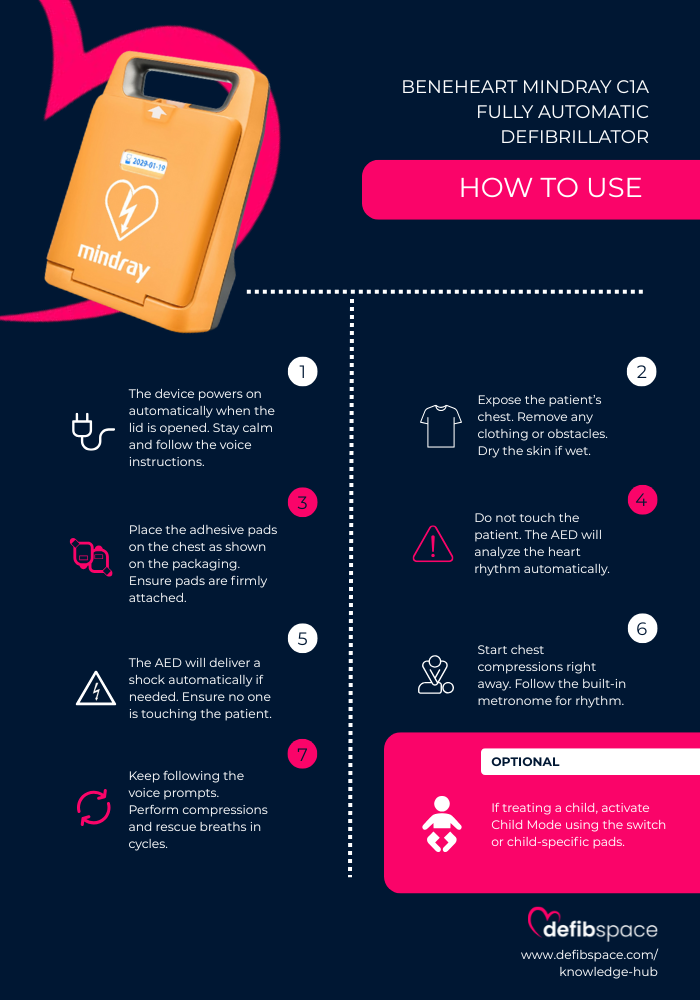How to use the Mindray Beneheart C1A
Unlike some models that require manual shock activation, the BeneHeart C1A delivers a shock automatically if one is advised. This reduces hesitation and ensures treatment is not delayed.
The device’s metronome helps rescuers keep the correct rhythm during chest compressions, while the Child Mode option ensures it can be safely used across different age groups. These features are designed to simplify what can otherwise be a stressful and overwhelming situation.
Step 1: Power On and Follow Prompts
To begin, press the power button to switch on the device. The BeneHeart C1A activates immediately and starts giving clear, calm instructions. At this stage it is important to remain focused and listen carefully. The defibrillator is designed to lead you through each action in sequence, so even if you are unfamiliar with the equipment, you can follow along with confidence.
Step 2: Expose the Chest and Attach Pads
Next, expose the patient’s chest by removing or cutting away clothing. The electrode pads are packaged with clear diagrams that show exactly where to place them. One pad is applied to the upper right chest, just below the collarbone, and the other on the lower left side, beneath the armpit. Once positioned, press each pad firmly to ensure good contact with the skin. It is important that nobody touches the patient once the pads are in place, as the device will shortly begin rhythm analysis.
Step 3: Allow the Device to Analyse
When the pads are attached, the C1A automatically begins analysing the patient’s heart rhythm. The device will clearly announce when this is happening. During analysis, it is vital that no one makes physical contact with the patient, as movement can interfere with the reading. After a short pause, the defibrillator will confirm whether a shock is required.
Step 4: Shock Delivery
If the heart rhythm is shockable, the BeneHeart C1A will deliver the shock automatically. This removes the need for the rescuer to press a button, ensuring that no time is lost. As with rhythm analysis, you must not touch the patient during this stage. The shock is intended to restore a normal rhythm and is followed by immediate CPR guidance. If no shock is advised, the device will skip this step and move directly to CPR instructions.
Step 5: Begin CPR with Guidance
Once analysis and shock delivery are complete, the C1A instructs you to begin cardiopulmonary resuscitation. The built-in metronome provides a steady rhythm for chest compressions, helping you maintain the recommended pace. The sequence is thirty compressions followed by two rescue breaths. The device repeats instructions to ensure you stay on track, and will guide you through further cycles of CPR until it is time for the next rhythm check.
Step 6: Use Child Mode if Required
If the patient is under eight years old or weighs less than 25 kilograms, the Child Mode function should be activated. This is done by sliding the switch on the device. In Child Mode, the BeneHeart C1A automatically adjusts the energy level of the shock and modifies the instructions to suit paediatric resuscitation. If paediatric pads are available they should be used, although adult pads may be used in an emergency if no alternative is present.
Step 7: Continue Until Emergency Help Arrives
The defibrillator continues to guide you through alternating cycles of CPR and rhythm analysis. These should be followed until professional help arrives, the patient shows signs of recovery, or you are unable to continue. The device ensures that life-saving interventions are maintained consistently, even in the hands of an untrained bystander.
How to use Mindray C1A infographic
Did You Know?
According to the British Heart Foundation, survival rates from sudden cardiac arrest fall by up to 10% with every minute that passes without defibrillation. Immediate CPR combined with early use of a defibrillator like the BeneHeart C1A can more than double survival chances.
Human Observation
In many workplaces, defibrillators are installed but their location is not always obvious. Staff often walk past cabinets without noticing them, especially in corridors or reception areas. Clear signage and regular awareness sessions are essential to ensure that people know where the defibrillator is kept and feel confident to use it in an emergency.
Sources
Mindray BeneHeart C1A Product Page
Manufacturer overview with technical details, features and operating modes.
https://www.mindray.com/en/product/BeneHeart-C1A.html
Resuscitation Council UK – AED Guidance
Official advice on the use and placement of defibrillators in community and workplace settings.
https://www.resus.org.uk/library/2021-resuscitation-guidelines/automated-external-defibrillator-aed
British Heart Foundation – Cardiac Arrest Survival Statistics
Provides survival rate data linked to early CPR and defibrillation.
https://www.bhf.org.uk/informationsupport/heart-matters-magazine/medical/emergency-life-support/cardiac-arrest
MHRA Guidance on AEDs
Government advice on safe use and regulation of automated defibrillators in the UK.
https://www.gov.uk/guidance/automated-external-defibrillators-aeds-in-public-places
Mindray BeneHeart C1A Demonstration Video (YouTube)
A practical, step‑by‑step demonstration guiding power-on, pad placement, rhythm analysis, shock delivery, CPR and use of Child Mode.
https://www.youtube.com/watch?v=tLiZOi0kzUs&ab_channel=MindrayIndia


